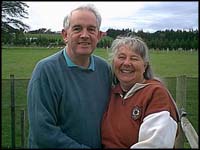(2) Long-Term Plan
As we mention frequently throughout our tutorials, planning is everything. It's what makes the difference between tedious and interesting videos.
What normally happens when you get out your video camera? Very few people attack their shooting with any purpose other than to "film what happens" or get some "video of the scenery". This haphazard approach is the real reason that people all over the world dread watching home videos. It doesn't work - it results in meandering, disjointed videos with no purpose.
A common remark about high quality home videos is that they "flow well". The reason is simple - these videos have been planned that way.
Everything you shoot should be part of a larger plan. Individual shots are only part of a story, so you need to be clear about what story you're trying to tell, and how to go about telling it.
Ask yourself this: What exactly do you want to have in 5 years time? In 25 years? When your grandchildren are grandparents?

If, for argument's sake,
you want the next 50 years of your family's life compressed into 10 hours of video
footage, that means accumulating 1 minute of footage per month over that time. If, on the
other hand, you are currently filling a 3-hour tape every month, then in fifty years time
your grandkids will have an impressive 1,800 hours of video to watch.
You don't have to plan that far ahead, but it does make sense to be thinking about the
bigger picture.
Pieces
Here's one suggestion: You can structure your movies into a series of "pieces" or "segments". For example, your home videos over one year could be divided into a dozen or so pieces of 5-15 minutes each. They could be such things as: "Johnny's birthday", "The family holiday", "A visit to Jane's school", "A guided tour of the house", and so on. Rather than a random compilation of shots which don't really flow, the result is a "home movie" with distinct "scenes". Each piece could begin and end with a fade-to-black, to separate them in time from each other.
In order to achieve this, you'll need to plan each piece to fit into your long-term goals. That's where your short-term plan comes in (see next page).
One-Off Projects

If you're making a one-off project (such as a wedding), the considerations are obviously different, and you won't have the same type of long-term plan. Still, you must know what you want the finished product to come out like. If you don't, you're relying on luck.
What exactly will the video be used for? Who is the intended audience? How long should it be? What are the important things to include, what can you live without, and what will bore your audience to sleep?
The next step is the short-term plan...